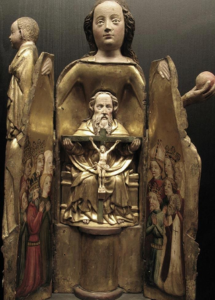
Arquivo para a ‘Noosfera’ Categoria
The desired and not built peace
 We know that the “pax romana” was the surrender to the empire that dominated the good face of the civilized world at the time, it is true today that there were already people in various parts of the planet, but their paleontological records do not leave many marks of their cultures, and perhaps as Rousseau thought ‘the good savage’ lived in peace, but in the natural conflict with nature.
We know that the “pax romana” was the surrender to the empire that dominated the good face of the civilized world at the time, it is true today that there were already people in various parts of the planet, but their paleontological records do not leave many marks of their cultures, and perhaps as Rousseau thought ‘the good savage’ lived in peace, but in the natural conflict with nature.
The “eternal peace” elaborated by the idealists and idolized by the worshipers of the “modern state” is not deepened, because in fact for many this will be the state, excuse the final irony of humanity and should only be perfected. Kant published in 1798, in a Berlin magazine, the essay “Announcement of the forthcoming signing of a treaty for perpetual peace in philosophy”, which was a resumption of his essay two years earlier: “For perpetual peace”, that was confined in its philosophy.
This is because the goal was to resolve peace within a single state, or in terms of relations between different states, which we can see even with the emergence of the UN and the rise of democratic nations, which in essence the idea of state remains enlightened. .
From this essay it can be assumed that what the philosopher understood by philosophy means that if systems of philosophy found a solution to their conflicts they could help political systems to resolve their conflicts, so it remains in the idealistic field.
The conflict between object and subject, which supposes that it is in the object that is the conflict and not in the subject is the hypothesis of the idealism/enlightenment system, but it is in the facticity of the historical subjects that the conflicts are, I do not understand as the historicity romantic because facticity is the Heideggerian concept of the subject thrown into the world with his facts.
Thus, what is meant by peace beyond idealism is that which can be built on the facticity of everyday life, in every conflict encountered in every fact, without being confined to theoretical or philosophical assumptions, but where the “being thrown” is. in the world”.
Peace, therefore, is built and not an agreement between states or within them, the peace treaty of the 1st. world war led to the second, some readers of world history say, the fact is that there were two wars and the “modern” states not only did not avoid, but are authors. “If you want peace, build peace,” said an Italian politician, very few understanding this.
A post-pandemic will be problematic, it may even lead to a civilizational crisis, where many measures should be taken from now on.
The originality of Being in Heidegger
The great question of Being in contemporary philosophy emerged from the thought of Martin Heidegger, a student of Husserl from which he inherited phenomenology as a method, essentially proposed to penetrate the question of being.
philosophy emerged from the thought of Martin Heidegger, a student of Husserl from which he inherited phenomenology as a method, essentially proposed to penetrate the question of being.
Although it has been studied by philosophy at all times, even Kantian idealism has an ontology that is displaced from Being to the subject, it already existed in Plato as an idea (Platonic eidos is not Kantian) and Aristotle as substance.
The being does not manifest directly, but always with the being of the being, you can play a joke with the contemporaneity that is the sick Being, because the Being of the Being is hidden in appearance.
One can seek pure Being in an ethereal existence of a God, but it is the existential door through man that one has access to Being, in this case Heidegger is applying the phenomenological method, he departs from man in fact (not idealized by example), let it manifest itself as it is and only then try to understand it in its manifestation after the presence.
Its first existence is being-in-the-world, one of the most widely accepted translations for Dasein, but as this being is also a Being-in-Situation, Heidegger’s careful reading can clarify this, I make a translation of being-being itself. – in the world, because Heidegger also uses the worldview (Weltanstchauung), which is open to the world and the cosmos, including the worldview.
This concept is important for Heidegger’s understanding of Being because it means this worldview as the circle of beliefs, affects, interests, and even philosophical concepts that Being has, even if it does not study philosophy, Being is “being-in-a-situation” that It does not mean just place or even context, but the very vision one sees in seeing the world, its “worldview”.
So many ideas and beliefs seem obvious to a person, but practically all of them are tied to temporal situations and thus limited by the “situation” in avise, that does not exclude thinking e the life.
This “abode” as an asceticism is described in the passage where the disciples ask the Rabbi (teacher), where He lives (Jn 1,38-39) and he said “Come and see”, they went and stayed with Him that day, where is your address?
For a spiritual ascesis
What we see beyond the crisis and cultural night, beyond a deep social crisis without a thought that catalyses the real forces of society that point to the future, is also a night of God, educator Martin Buber describes it as God’s Eclipse.
beyond a deep social crisis without a thought that catalyses the real forces of society that point to the future, is also a night of God, educator Martin Buber describes it as God’s Eclipse.
Buber wrote in his book: “I later built for myself the meaning of the word ‘mismatch’, through which was roughly described the failure of a true encounter between human beings. When, after another 20 years, I saw my mother, who had come to visit me, my wife, and my children from afar, I couldn’t look into her still astonishingly beautiful eyes without hearing the word “mismatch” somewhere as if it were. tell me.
I suppose that everything I have experienced over the course of my life about the authentic encounter has its first origin at that time in the gallery. ”(BUBER, 1991, p. 8). Thus revealing the true face of the “silence of God” of Judaism in which it has its roots, will be in another book the “I-Thou” where he will reveal an aspect of his asceticism which is “the encounter with the Other”, which for Buber more. than one person, your Tu has a divine essence, God inhabits the other.
These days there are two strong tendencies, and in both asceses there is in fact no spirituality beyond transcendence, or the activism that Byung Chul condemns as the “active vita” that leads to tiredness, or the idealistic subjectivism that can It seems to be religion but it is not, what it arouses is nothing but sentimentality, and can lead to “faithful” tears, not necessarily to God, if they do discover Him they must seek another true asceticism.
Thus it is possible that they will find God in one way or another, but there is no other way to remain in the faith, not of the blind but of those who have found a clearing, if indeed meditation and prayer are to remain, they are indispensable.
For those who have no faith, a good reading, separating passages and thoughts, living the moment as we wrote in the previous post, is fundamental, that is, also for reading can follow the rule of doing it without “gluttony”, try put the soul in silence, making a true “epoché”.
To those who believe always reflect that Jesus prayed, and asked his disciples to pray with him, and not to lose this practice, Jesus will tell the parable of the bad judge who does not want to attend the widow, but by his insistence and so that she does not. he curses, he answers, says the opening passage: “Jesus told the disciples a parable to show them the need to pray always, and never give up…”, which is in Luke 18: 1.
BUBER, Martin. (1995) Eclipse de Dios. México: Fondo de Cultura Económica, 1995.
Desert, existence and dreaming
Existence already (pointed in others posts) depends on  living the instant that passes, time of change imply to know and know that there are moments of desert in which existence itself seems in check at this moment must not stop dreaming, a future to come.
living the instant that passes, time of change imply to know and know that there are moments of desert in which existence itself seems in check at this moment must not stop dreaming, a future to come.
What we seek or what we find in the desert is the understanding of what we have developed this week in anguish, not the one that leads to frustration, but just without opposite, in the developed concept we aim not to live on borrowed meanings, to look at it as an opportunity.
The second feeling of desert is that which philosopher Kierkegaard has pointed to as repetition, the feeling that everything has stopped and there is nothing but the desert, existence has stopped and it may even seem that it has ended, there is another repetition that aims in the essentials. that is boy to go beyond.
She deals with frustration and keeps us dreaming, but we affirm it is not the pleasures, the fortune (here in the financial sense) and not even letting it happen and leaving the world as it is that dreams are found even in a desert.
Precisely because it is changing times, values and feelings are boiling, that we can find new dreams, achievable of course, but sometimes even crazy can be achievable.
What separates one from the other is not the depth of a dream, but the perpetuity of what one seeks, if we seek only the pleasures, the power or the preponderance over the Other, they are not dreams, they are at the very least evasive of true dreams, not they are generous to all mankind.
But what is most sought after is these transient dreams, and frustration follows them almost inevitably, of course some will get rich, will have ecstasies of value, but at a high cost.
It is like the biblical passage, when receiving the disciples of John the Baptist who lived in the desert, said the multitudes who followed him (Mt 11: 7-9): “What were you to see in the desert? A reed shaken with the wind? What did you see? A man dressed in fine clothes? But those who wear fine clothes are in the palaces of kings. 9So what were you to see? A prophet? ”, a prophecy is also a dream.
It takes philosophical anguish to dream, to enter a virtuous circle of a dream come true.
Anguish, existence and vanity
As we have already discussed, the anguish of our  time is the tension with Being, maintaining “authenticity with oneself”, not being carried away by the current of expectations and impositions of temporal powers, and thus dealing with the frustrations of holding firm perennial values and dealing with oneself. with the transients.
time is the tension with Being, maintaining “authenticity with oneself”, not being carried away by the current of expectations and impositions of temporal powers, and thus dealing with the frustrations of holding firm perennial values and dealing with oneself. with the transients.
From this stems the search for an existence where there is Fortune (our happiness), but the Greeks who used reference to the goddess Fortuna (picture), knew well that it was not related to the possession of goods, as stated Heraclitus of Ephesus: “if the If happiness were in the pleasures of the body, we would say happy oxen when they find peas to eat”, some prefer peas.
When we do not live the repetition as expounded by Professor Giacóia in the sense of seeking the essence, we enter the repetition of sameness that lives from fear, which leads us to live in impropriety, we do not attribute meaning (or meaning some prefer), we let others and circumstances attribute it, we live the worst alienation, the alienation of ourselves, running everywhere with full and empty agendas at the same time, frivolities said Sloterdik.
We live for a purpose that has no end, in the sense of goal, but “borrowed” meanings of daily life, conjunctures and contexts. Anguish produces the opposite effect. It opens up the possibility of finding what I am within a proper sense of life.
It is the reunion with the Self, open to the world and the Other, without implying either individual closure or depersonalization of the environment, today with the strong pressure of psychopower, as thinker Byung Chul Han defines the essential pressure of this time.
What we seek, what is our goal, should ultimately be seen as end, never as temporal: money, power, wealth or simply some vanity.
The eternal and the current fragility
There is no way to think of eternal without thinking of God, so religions that give up the divine figure need reincarnation, to human return, it is a time of crisis beyond the pandemic, a revolt by supporters of Trump exploded in the United States, the richest nation on the planet it’s bad.
During the week we worked on the capacity for dialogue and the search for coexistence between opposite poles, the time we live goes in the opposite direction, the result is the explosion of conflicts.
Outside the American situation, the global situation is no less problematic, new situations of lock-down by the pandemic, the emergence of economic crises and the enrichment of uranium in Iran point to the weakness of the world balance, we are just a little less fragile than fetuses.
What is expected, at least, from the voices that have balance and that seek to send world peace is that they are attentive to these dangers and intervene in the fragility of world convivialities.
Nobody with a conscience expects a worse situation, the year of the pandemic was strenuous, but resilience and the search for dialogue must be permanent in order to avoid disasters and even more difficult situations than those already imposed on us.
For those who believe, asking for divine action on such a complex situation, if man cannot act according to grace, divine reaction is inevitable, where sin abounded grace abounds, says a Christian maxim.
The biblical manifestation of God the Father, Jesus had been baptized and thus received contact with the Holy Spirit and from there came a Trinitarian manifestation (Jesus, the Holy Spirit and God) that made the voice of God an imperative, says the evangelist Marcos ( 1.11) “And a voice came from heaven: ‘You are my beloved Son, I put my good wishes in you'”, the time we live in is thus a time in which many extraordinary manifestations will show Divine love
Between the eternal and the temporal
There is no dualism between body and mind, as the idealists want, the mind exists in a body and interacts with it, there is what is temporal and what is eternal, if not in a strict sense at least in the broad sense, principles are needed to determine the values and what guide humanity in critical times of society, and the spiritual helps.
idealists want, the mind exists in a body and interacts with it, there is what is temporal and what is eternal, if not in a strict sense at least in the broad sense, principles are needed to determine the values and what guide humanity in critical times of society, and the spiritual helps.
Byung Chul Han, in a January lecture at the Barcelona CCB where he showed the tearing of our time between narcissism, self-consumerism and an absence of relationship with the other, which must revolutionize time, or the way we manage it.
He said of the other and in reference to the universities: “In any case, we live in a time of radical conformism: the university has clients and only creates workers, it does not form spiritually; the world is at the limit of its capacity; maybe that will short circuit it and we get that original animal back. ”
He stated at the Barcelona CCB: “The current acceleration diminishes the ability to remain: we need a proper time that the productive system does not allow us to have; we need some free time, which means standing still with nothing productive to do, but not to be confused with recovery time to keep working; time worked is time lost, not time for us. ”
Modern humanism criticized by his master Peter Sloterdijk who asserts this sense back to the original animal, of course, is not in the sense of wild animality, but the idea that he must regain his relationship with nature will not be saved and will even condemn planet. Sloterdijk clearly outlines these ideas in the video below.
What the natural man means and his relations with the eternal, now not only nature, but in a worldview of paradise and eternal life, means that we must look at remaining values.
When questioned by the Sadducees, who were a more aristocratic class in Judaism, about who a woman who would marry several brothers after their deaths, would tell them that believing in eternal life means that the people will no longer die, Jesus response the question would not make sense and also that God is “God of the living” (Luke 20:38).
Looking only at temporal values and conjunctural situations prevents us from seeing the future and the eternal.
Follows Peter Sloterdijk’s interview on the braziliam program Fronteiras do Pensamento *“Borders of Thought”).
New intimacy and new world
In intimacy, in our “bubbles” that generate our culture, we defend and promote our ideas, our values and what we want for a better world.
defend and promote our ideas, our values and what we want for a better world.
Christmas somehow still makes men sympathize and think generously about the future world beyond their bubble, their selfishness, and if this goes on for the year a new world may be born, even in a pandemic crisis that is already a broader crisis.
The reflections of Sloterdijk and other thinkers is how interiority has become an isolated world, like a “bubble”, and in it reflects our initial stage of our life in the maternal womb and extends through life, the analysis made by Sloterdijk ( also Bachelard does it in another way, see the post) it is like the biblical passage of the prophet Jonas in front of the whale, which is illustrative of this way of being, of seeking an “intimacy” of comfort.
By remaining in the whale’s womb, symbolically it is what we seek as a region of comfort, or security, in a hostile world where we must seek co-immunity, a defense where everyone can participate and enjoy a well-being.
The birth of Jesus for Christians means the announcement of this womb, of this “kingdom”, in these days we celebrate the coming through a child-God of this new time in a new world.
The biblical passage that reports the birth of Jesus says that Joseph and Mary went to Bethlehem, due to the census made by the Roman Empire: “to register with Mary, his wife, who was pregnant. While they were in Bethlehem, the days of childbirth were completed, and Mary gave birth to her firstborn son. She bandaged him and put him in the manger, as there was no place for them in the inn ”(Lk 2,5-7).
Spherelogy, intimacy and exteriority
It is not by chance that Sloterdijk praises Gaston Bachelard at the beginning of Spheres I, his approach has a deep dialogue with Bachelard’s poetics of space, as both the intimacy theme is linked to articulation and two conceptions: “exteriority” and “space”.
at the beginning of Spheres I, his approach has a deep dialogue with Bachelard’s poetics of space, as both the intimacy theme is linked to articulation and two conceptions: “exteriority” and “space”.
The first point is to understand that the phenomenological approach has a direct influence on Heidegger’s Being and Time, at the same time that they outline criticisms, even though Heidegger did not dwell deeply on the theme, it is between the lines of his work.
In the opening chapter, Sloterdijk refers to the human with the so-called “erratic blocks”, in which the astonishment at the “I” in the world would be like these blocks that “are there”. In view of this, the possibility of consciousness being made with the world opens up.
The recognition of this condition of being played randomly in the world does not happen smoothly, but through “the unexpected, the rebellious and the disturbing that the ecstatic personal finding can be” (SLOTERDIJK, 2008, p. 16), erratic blocks were geological formations displaced in the last ice age.
The first volume is dedicated to the issue of intimacy and Sloterdijk part of the mother-baby relationship, we are joined to another body from the moment of conception, by a “rejected organ” that is the placenta, whereas in other times it was somehow ritualized, now the “original companion” is discarded as garbage.
He will point out from this (as he did with the prophet Jonas) to look for ways not explored by current philosophy, “the relationship, the connection, the fluctuation in an within-something and in a with-something, being contained in between” (SLOTERDIJK, 2016) and for this reason his spherology is his essential work.
I highlight Bachelard’s work because for him there is a perspective that I consider broader, that of describing the intimate experience in addition to the experience with the other, with the totality of the world.
This is also the case in Bachelard, in opposition to Heidegger, where he states: “From our point of view, from the point of view of a phenomenologist who lives from his origins, the conscious metaphysics that is located at the moment when being is ‘thrown into the world’ it is a second position metaphysics.” (BACHELARD, 1993, p. 27)
While Sloterdijk is the womb the primary “space”, the place of well-being, for Bachelard it is the home, the paradigmatic place of well-being and protection.
If we understand interiority as the place where we combine these two sensations: the womb that is the primordial house, and the house that is the space in the world where we co-inhabit with other beings, not just humans, of course, we can combine interiority and intimacy, and we have a new horizon not only metaphysical, but human, divine and between these two conjugations: the original womb, the common home and the final destination that interiority provides.
BACHELARD, G. (1994) A poética do espaço. Trad. Antônio de Pádua Danesi. Bransil. São Paulo: Martins Fontes.
SLOTERDIJK, P. (2008) O Estranhamento do Mundo. Trad Ana Nolasco. Lisboa: Relógio d’Água, 2008
SLOTERDIJK, P. (2016) Esferas I: bolhas. São Paulo: Estação Liberdade.
Noogenesis: matris in gremio
In tour 10 of Spheres I, Peter Sloterdijk makes a connection  between the conception of Mary (the name Concept comes from conception) and tragedy, and a text that is certainly known to the philosopher is Hörderlin’s interpretation of the Greek tragedy Oedipus King of Sophocles, where he uses the term aorgic for the search for Epic to know who he is, the more he searches, the less conscious consciousness becomes towards tragedy.
between the conception of Mary (the name Concept comes from conception) and tragedy, and a text that is certainly known to the philosopher is Hörderlin’s interpretation of the Greek tragedy Oedipus King of Sophocles, where he uses the term aorgic for the search for Epic to know who he is, the more he searches, the less conscious consciousness becomes towards tragedy.
The tragedy is that father Laio, had heard from the oracle of Delphi, that his son would kill him and marry his mother Jocasta, the king hands him over to a poor shepherd to kill him, but the shepherd raises him and then he goes stop at the hands of Polybius, king of Corinth who raised him as a son, but the tragedy is fulfilled and then Oedipus kills King Laius, who was his real father and marries Jocasta when he becomes aware of the blind truth, the tragedy has more details, here it is just to understand the aorgic.
Sloterdijk inverts this story to talk about Christian mariology, in his tour 10 Matris in gremio (mother’s lap or lap), where after analyzing the text De humanitae conditionis in miseria by Lotário de Segni (1160-1216) that would become Pope Inocencio III, who says that the liquid that would feed the child is the same as the menstruation that would be interrupted with the pregnancy.
Sloterdijk, states that “there is no doubt that Jesus, even in gremio, must have been provided with a different dietary plan” (Sloterdijk, 2016, p. 557), and will use Question 31 from the third book of the Summa Theological of Thomas de Aquino, however the important thing is his “conception”.
Tomás de Aquino’s quote is important because it explains the noogenesis:
“… Because, by the action of the Holy Spirit, this blood is collected from the Virgin’s lap and formed into a fetus. That is why it is said that the body of Christ was formed by the most chaste and pure blood of the virgin ”(Aquino, Suma Theológica III, 31, 5, 3, SP: Loyola, 2001-2002).
In the biblical text, Mary, although promised to Joseph, he has not yet married her, says the biblical text: “Mary asked the angel,” How will this happen if I don’t know any man? ” (Lk 1,34), and receives the answer that will be by the action of the spirit, under the shadow of the power of the Most High.
And so the idea was born that Mary was taken to heaven, but it is also the birth 11 centuries before being accepted, the dogma of her Immaculate Conception (which by popular use became Conceição), thus “it is the very matrix of God who miraculously offered the sculptor the material of his sculpture, and to God the material to become a man… ”(Damasceno apud Sloterdijk, 2016, p. 558), which thus pre-announces Mary’s aortic action with Jesus and God- Father, as a pericoresis in extremis (in the photo, also used by Sloterdijk, Virgin with Overture, late 14th century, Cluny Museum in Paris), also cited by Sloterdijk.
Sloterdijk, P. (2016) Esferas I, trad. José Oscar de Almeida Marques, BR-São Paulo: Estação Memória editors.

